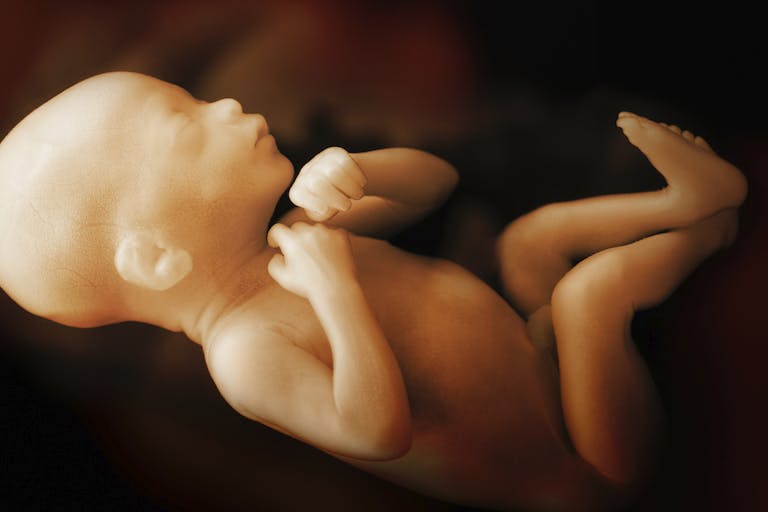
A growing number of Americans call themselves ‘pro-choice’ – but what’s really behind it?
Nancy Flanders
·
New peer-reviewed report: Preborn children may feel pain as early as 8 weeks
A new report indicates that preborn children in the womb may be capable of feeling pain earlier than is commonly thought — a conclusion that supports previous studies. Dr. Bridget Thill’s article, “Fetal Pain in the First Trimester,” was published in December 2021 in The Linacre Quarterly, and it considered research from medical journals published from 1936 through 2021.
The peer-reviewed article concluded that the capacity for the preborn child to feel pain begins during the first trimester — and for anyone to deny this is “no longer tenable.”
Supporting evidence
Thill notes that there are five key pieces of evidence that point to the fact that fetal pain perception has implications for fetal surgery and abortion and that fetal pain perception begins during the first trimester:
“The neural pathways for pain perception via the cortical subplate are present as early as 12 weeks gestation, and via the thalamus as early as 7-8 weeks gestation.”
“The cortex is not necessary for pain to be experienced.”
“Consciousness is mediated by subcortical structures, such as the thalamus and brainstem, which begin to develop during the first trimester.”
“The neurochemicals in utero do not cause fetal unconsciousness.”
“The use of fetal analgesia suppresses the hormonal, physiologic, and behavioral responses to pain, avoiding the potential for both short- and long-term sequelae.”
This clear existence of fetal pain causes a conflict, said Thill, between doctors actively helping patients — in doing good through mercy and kindness — and doctors doing no harm. At what stage during development children are able to feel pain has been up for debate for more than two decades, to the point that many doctors wrongly believed that even newborns were incapable of feeling pain — even subjecting infants to open-heart surgeries without pain medication. Today, that is clearly a horrific thought and even preborn children in the second and third trimesters who undergo surgery are given analgesia or anesthesia to eliminate pain and improve their outcome. Preborn babies subjected to abortion procedures, however, are not afforded that same act of charity.

While pro-abortion Dr. Stuart Derbyshire has backpedaled on his previous position on fetal pain to now state that the capacity to feel pain begins as early as 12 weeks and that “the minimal necessary anatomy for pain processing is present at 7-8 weeks gestation,” pro-abortion groups such as the Royal College of Obstetricians and Gynaecologists’ (RCOG) and the American College of Obstetricians and Gynecologists (ACOG) continue to argue that fetal pain is impossible until at least 24 weeks gestation and that the preborn child can not perceive that pain until “late in the third trimester.”
READ: The science of fetal pain is an inconvenient truth for pro-abortion ideologues
Yet, the American Academy of Pediatrics uses pain assessment tools for preterm infants born as young as 23 weeks gestation which use behavioral and physiological indicators of pain — such as facial expressions and limb movements — to determine and treat pain in these premature newborns. Preborn babies in the first trimester have also exhibited facial expressions and limb movements in reaction to stimuli — including abortion tools.
Fetal pain and abortion
Not only is it possible for babies as young as eight weeks to feel pain, but they may actually be hypersensitive to that pain, according to the most recent report. “Evidence also suggests the fetus has a heightened sensitivity to pain due to the lack of descending inhibitory pathways which appear in the postnatal period,” states Thill, meaning the fetus is extremely sensitive to pain, with that hypersensitivity diminishing after birth.
Yet, preborn children who are deemed unwanted or unworthy are routinely subjected to violent abortion procedures such as the D&E abortion — in which the child’s limbs are torn from the body and her skull crushed. ACOG’s abortion guidelines do not include recommendations for fetal analgesia prior to this brutal abortion procedure.
In addition, third-trimester abortions are often carried out with the use of an injection of a lethal drug such as potassium chloride or digoxin to cause cardiac arrest so a stillbirth can be induced. Yet, as Thill pointed out, the use of potassium chloride to carry out the death penalty for convicted criminals or to euthanize animals “must be preceded by anesthesia and confirmed unresponsiveness” because such injections are “known to cause pain.”
Animals, convicted criminals, and “wanted” preborn babies are all treated with mercy through the use of pain medication or anesthesia, while preborn children considered “unwanted” or “sick” are killed without any regard to their pain.
“If the fetus is capable of experiencing pain and suffering, which research convincingly indicates is possible beginning in the first trimester,” wrote Thill, “then arguably a moral obligation exists to prevent, mitigate, and treat fetal pain, whenever it can foreseeably be anticipated, according to the principles of justice, beneficence, and nonmaleficence. This concern arises in a notable way for cases of abortion or feticide. When these principles are applied unevenly in consideration of the pregnant woman rather than the fetus, the autonomy of the woman and the degree of maternal-fetal attachment may be framed as preeminent considerations that reduce the need to attend to or address the reality of fetal pain (Arora and Salazar 2014; Furedi 2001).”
The pro-life movement has largely addressed this issue with the introduction of fetal pain bills that are meant to restrict abortion once pain is possible in preborn children, but those laws typically restrict abortion after 20 weeks despite growing evidence that preborn babies can feel pain much earlier. Meanwhile, groups including Planned Parenthood have fought these laws on the grounds that they are unconstitutional (and, in the corporation’s opinion, irrelevant to the question of abortion).
But the truth is, when or if a human being can feel pain does not matter in a discussion concerning when and how it is acceptable to kill innocent human beings. It is never acceptable to kill innocent human beings — inside the womb or out — regardless of their ability to feel pain. Research on fetal pain has now clearly demonstrated the humanity of the children inside the womb and the obvious existence of life inside the womb, and it has proven that there is no point in time or development when killing should be allowed.
Editor’s Note 2/16/22: Changes were made to this article for clarity.
“Like” Live Action News on Facebook for more pro-life news and commentary!
Live Action News is pro-life news and commentary from a pro-life perspective.
Contact editor@liveaction.org for questions, corrections, or if you are seeking permission to reprint any Live Action News content.
Guest Articles: To submit a guest article to Live Action News, email editor@liveaction.org with an attached Word document of 800-1000 words. Please also attach any photos relevant to your submission if applicable. If your submission is accepted for publication, you will be notified within three weeks. Guest articles are not compensated (see our Open License Agreement). Thank you for your interest in Live Action News!

Nancy Flanders
·
Politics
Cassy Cooke
·
Analysis
Cassy Cooke
·
Analysis
Nancy Flanders
·
Newsbreak
Angeline Tan
·
Human Interest
Nancy Flanders
·
Politics
Nancy Flanders
·
Politics
Nancy Flanders
·
Abortion Pill
Nancy Flanders
·
Politics
Nancy Flanders
·
Human Interest
Nancy Flanders
·